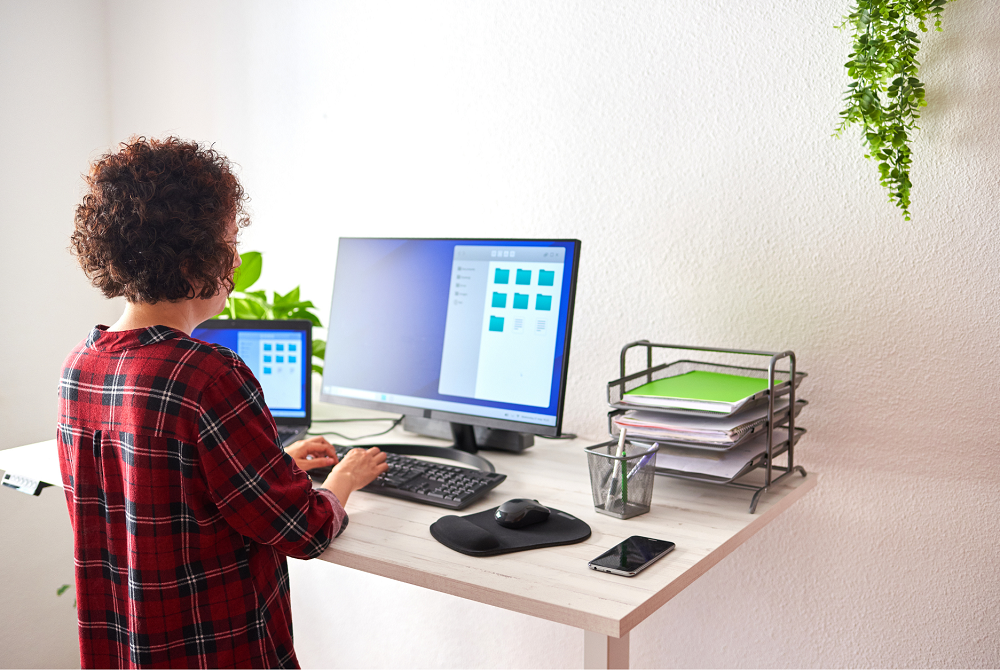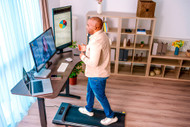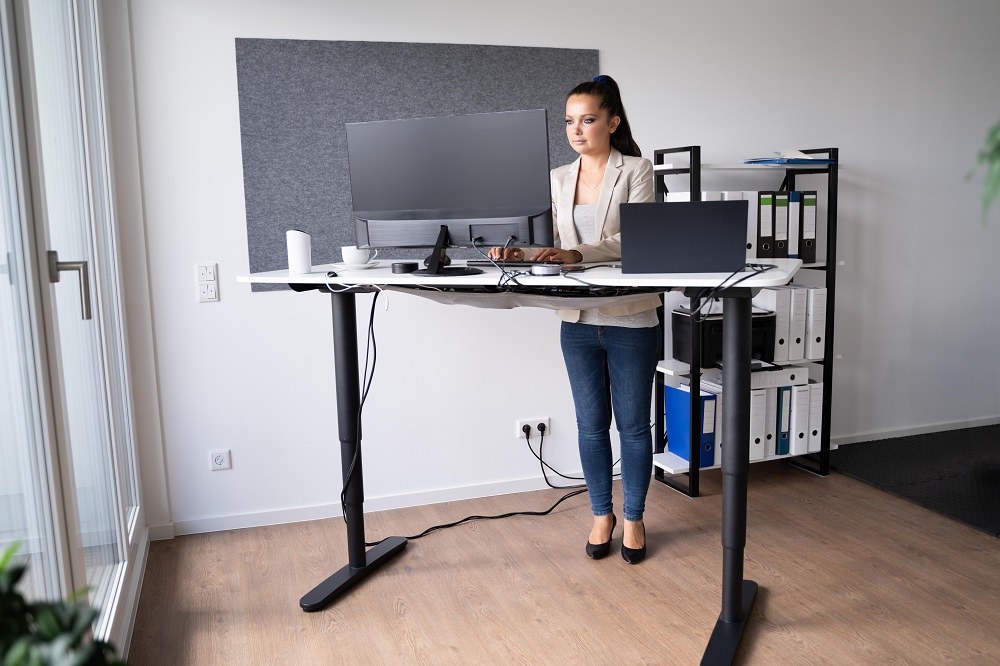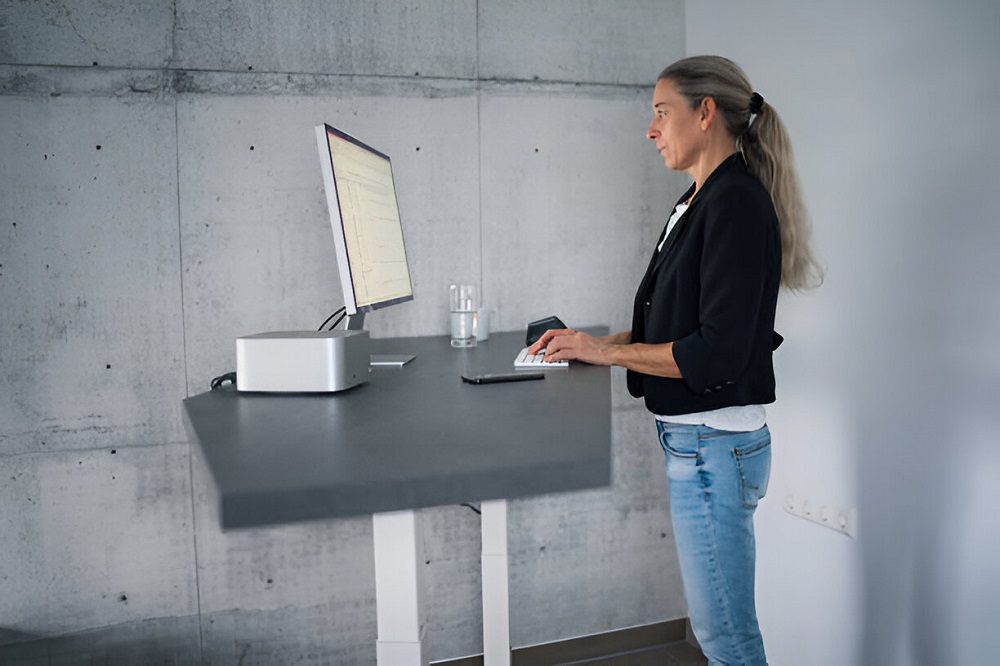Nowadays, people are concerned about their health, and the juggling to maintain work-life balance alongside health can be quite overwhelming. Usually, people spend most of their time sitting during the working day, which is bad for their physical health.
But what if someone says you can participate actively to complete your daily health goals? What if you could burn calories and work at the same time? Yes, it is possible to have a standing desk!
But how can you ensure you use a standing desk properly to maximize calorie burn? This blog will discuss this in detail.
The Science Between Standing Desks and Calorie Burn
Despite what many people believe, standing is more than just not sitting down; it's a mild exercise that helps your body move and your metabolism work. Standing at your desk for a portion of the day can burn more calories than sitting.
According to a published study, standing burns 0.15 more calories per minute than sitting. Despite the seemingly small difference, it accumulates with time. For example, compared to sitting, you could burn an extra 130 calories if you stood for three hours during an eight-hour workday.
Moving back & forth between standing and sitting can help you burn more calories. Compared to sitting alone, shifting from sitting to standing and back keeps your muscles working and your metabolism functioning.
Although it is not the best solution for losing weight or becoming fit, it does contribute to an overall active lifestyle.
Is it Possible to Burn Calories at Work?
Every little thing helps, and that is true when it comes to burning calories while working. It is not essential to aim for an intense workout at your desk; instead, small adjustments over time can have a bigger impact on your health.
Beyond helping with weight loss, burning more calories can improve mood, boost focus, and even help sustain energy levels, improving general well-being. Adopting a standing desk lifestyle can become vital to a more health-conscious workplace.
Exercise One Can Consider Doing at a Standing Desk

One can experience several benefits of standing while working. You can stretch out easily when you need to and even get your muscles working in a light manner. You can even try some exercises while standing that will help you burn more calories, and those are:
- Standing Leg Lifts
Maintaining your posture straight, raise one leg out to the side. Repeat this exercise ten more times, then move on to the opposite leg. It is an easy workout that improves the strength of your legs and core.
- Standing Desk Squats
Position yourself so that you are going to sit, but instead of going to your chair, squat for a short while and then stand back up. Perform a set of ten whenever you want to switch things up quickly.
- Calf Raises
After placing your feet hip-width apart, gradually lift your heels to the point where you are standing on your toes. Repeat after lowering your heels once more. Throughout the workday, try to reach two sets of fifteen. This exercise can keep your lower leg muscles engaged.
Tips You Should Consider for Maximizing the Calorie Burn
A standing desk helps you lose calories, but you must ensure you can use the desk correctly. But if you are not aware of the use of standing desks, you can read the following points:
Include Proper Desk Ergonomics
The science of creating an ergonomic workplace is called ergonomics. When used with standing workstations, it guarantees a relaxed and healthy posture that reduces physical stress on your body.
This maximizes your ability to burn calories by preventing pain and discomfort and enabling you to stand for extended periods of time.
Here's what proper desk ergonomics entails:
- Find the Right Height: How high should a standing desk be?The perfect desk height is standing with your shoulders relaxed and elbows at a 90-degree angle. Ensuring correct arm and wrist alignment lowers the chance of developing carpal tunnel syndrome and other repetitive strain injuries (RSIs).
- Monitor Placement: The top of the display should be at eye level and positioned immediately in front of you. This keeps your neck from straining as you look up or down during your work.
- Keyboard and Mouse: When typing, keep your wrists straight and your keyboard and mouse within easy reach. Consider using a wrist rest for increased comfort and to ensure good posture.
- Footrests: Use a footrest if you frequently find yourself standing on your tiptoes or shifting your weight. This helps you change up your standing posture during the day, lessening fatigue and improving circulation.
These ergonomic concepts are the cornerstone of a cozy and healthful standing desk experience. Never forget that an ergonomic desk lets you concentrate on your work without compromising on your work.
Do Not Just Stand, But Also Move!
Your body burns more calories as you move. So move your body—sway, stretch, fidget, shift, dance, etc. Furthermore, you don't want to lock your knees in position.
Additionally, it is recommended that you get a Topo Mat to match your desk, as this will promote even more of that subtle movement.
Alternate Frequently Between Standing and Sitting
Without question, excessive sitting is detrimental to your health. That does not, however, imply that you should stand all day.
It is also believed that prolonged standing damages your legs' tendons, muscles, and other connective tissue and may even result in varicose veins. Thankfully, this is preventable by just switching between sitting and standing.
Although some studies are still in their early phases, a 1:1 or 2:1 sitting-to-standing time ratio seems ideal for comfort and energy levels without impacting productivity. This implies that you should stand for one hour for every one to two hours you spend sitting at your desk. Every 30 to 60 minutes, try to switch between standing and sitting.
Try Adding an Active Seat to Your Office
Active seats, which encourage movement and maintain your muscles somewhat engaged, are ideal for standing desks. This has the potential almost to treble your daily non-exercise activity at work.
Step Up Your Workspace Properly
Ensure that the height of your standing or height-adjustable workstation is appropriate. This implies that your elbows should be at about a 90-degree angle and that your wrists and forearms should rest on the table surface.
When you look forward, the top of the screen should be at eye level. Your mouse and keyboard also have to be at eye level and in close proximity to you.
Practical Tips for Standing Desk Success

Switching to a standing desk can alter your life. You can utilize a standing desk for better health and productivity. But it requires some preparation and getting used to it.
Here are some tips to ensure a smooth & successful switch:
- Invest in the Right Equipment: A high-quality standing desk that is easy to raise or lower is necessary. For optimal keyboard placement, think about using an anti-fatigue mat, a footrest for comfort, and a wrist rest.
- Adjust Gradually: At first, try not to stand for the entire day. As your body gets used to the shorter intervals, progressively extend them in length.
- Listen to Your Body: Look for any pain or discomfort, and take pauses or correct your posture as necessary. Never hesitate to take a seat when necessary.
- Stay Hydrated: Standing for a long time may cause dehydration. So, make sure you drink plenty of water throughout the day.
- Find an Accounting Partner: A friend or coworker who uses a standing desk might inspire and encourage you. Encourage one another to offer tips and stand for a predetermined amount of time.
- Make It Fun: You can stand while listening to music, taking phone calls, and brainstorming ideas. Stay upright when accepting calls, playing music, or coming up with ideas. Look for opportunities to move during the workday that you love.
Conclusion
By incorporating these tips and prioritizing ergonomics, you can transform your standing desk into a powerful tool. It can maximize calorie burn, improve overall health, and boost your productivity at work. So ditch the chair, embrace the stand, and watch your well-being flourish!




